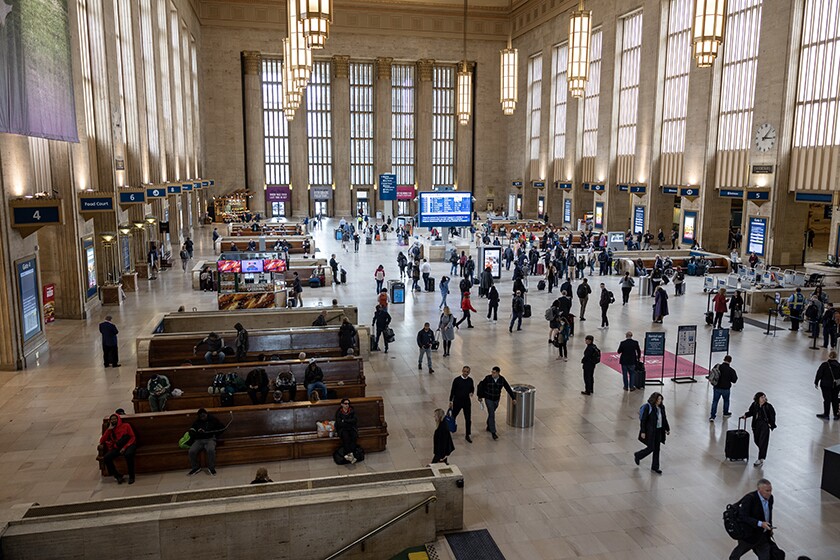
(Photographs by David Kidd)
In Brief:
A century ago, in the waning years of the City Beautiful Movement, the Pennsylvania Railroad (PRR) and the city of Philadelphia were jointly developing planned improvements to their transportation infrastructure. Collectively known as the “Philadelphia Improvements Project,” civic leaders sought to build a grand parkway, not far from where the PRR would construct a monumental new station on the city’s west side.
Considered to be one of the last of the great train stations to be built, Philadelphia’s 30th Street Station opened to the public in 1933. Clad in Alabama limestone, its classical revival exterior features a towering portico on the west and east facade, each featuring 10 Corinthian columns, 71 feet tall and 11 feet in diameter.

Despite an outward appearance inspired by the past, Philadelphia’s newest station had several advanced features for its time including an elaborate intercom system and pneumatic tube messaging network. The building also included more than 3,000 square feet of hospital space and a chapel that was later used as a temporary morgue during World War II. The roof over the main concourse was reinforced so that it could support small aircraft, although it was never put to the test.

Changing but Unchanged
After 90 years of service, 30th Street Station is still an important part of Philadelphia’s intercity and commuter transportation network, serving also as a hub for local subway, trolley and bus routes. Well over 100,000 people pass through the complex on a typical weekday. It is Amtrak’s third busiest station, after New York and Washington.

An Amtrak publication at the time commemorated the project’s completion as “just the beginning for a far reaching and ambitious plan to transform almost 100 acres of the city into an international center of business, commerce, arts, entertainment and living spaces.” This was just one of several plans and proposals to develop the area around 30th Street Station since it opened in 1933, all of them falling short of expectations.

Planning for the Future
Unveiled in 2016, the “Philadelphia 30th Street Station District Plan” is by far the most ambitious vision yet for the station and its surroundings. Led by Amtrak, Brandywine Realty Trust, Drexel University, the Pennsylvania Department of Transportation and the Southeastern Pennsylvania Transportation Authority, the plan is “a comprehensive vision for the future of the 30th Street Station District in the year 2050 and beyond.”
With $10 billion in public and private investment, the joint master plan foresees an entirely new neighborhood of residential and commercial office towers, retail, cultural amenities and 40 acres of open public space, all of it built atop railyards and on land adjacent to the station. In total the massive project could result in as much as 18 million square feet of new development. The district plan is expected to proceed incrementally over several decades, in order to be economically feasible.

Amtrak
Renovation work is now underway on the historic station’s interior, incorporating modern amenities and the improved operational efficiencies needed to handle a projected doubling of passenger volume over the next 25 years. “We're taking a very sensitive approach as to how we chose materials for the new stuff,” says Gail Barman, Amtrak program manager for the Gray 30th Street Station redevelopment project. “Everything is intended to maintain the historic core and character of the building.” Work is expected to be completed by the end of 2026.

Gone but not Forgotten
Despite the restoration’s attention to historic detail, some things long associated with the William H. Gray III 30th Street Station have left the building. In the 1970s, Amtrak installed a mechanical split-flap departures board that made a distinctive clickety-clack sound as it updated boarding and gate information. It was the last of its kind in use on the entire Amtrak system. Citing ADA non-compliance, the board was taken down from its perch a few years ago and shipped off to a museum.
The newsstand was once an indispensable feature of the main concourse. Today, the station’s remaining pared-down newsstand still sells magazines, books, candy and souvenirs. But as of last month, they no longer carry newspapers. No one was buying them.
Barring a renewed interest in newsprint, picking up a newspaper inside 30th Street Station is an activity likely never to return. The old-fashioned departure board, however, will be back. Amtrak has promised to rescue the beloved clicking contraption from its temporary museum home and reinstall it in the main concourse, but only as a decorative reminder of the grand station’s past.













